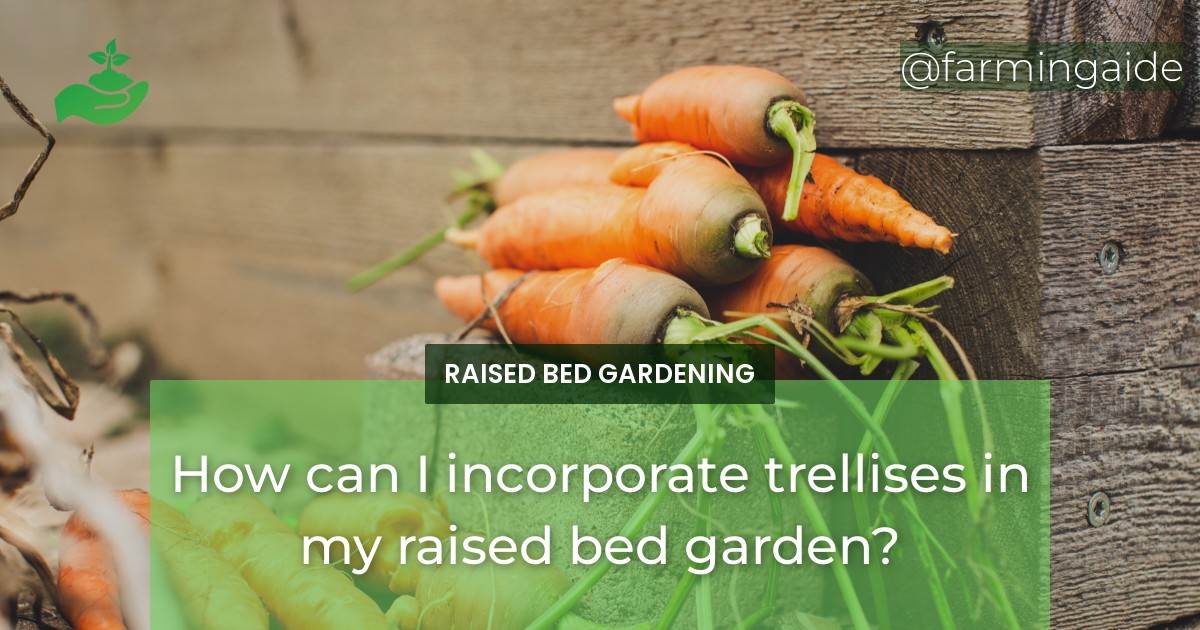Incorporating trellises in raised bed gardening is a great way to maximize space, increase yield, and add an aesthetic touch to your garden. Trellises are structures that provide support for climbing plants, allowing them to grow vertically and save space. Additionally, they help to prevent pest and disease problems by keeping the plants off the ground. In this article, we will discuss the benefits of using trellises in raised bed gardening, the different types of trellises to use, choosing the right climbing plants for your trellis, installing trellises in raised bed gardens, maintenance tips for trellises, and the final thoughts and benefits of incorporating trellises in raised bed gardening.
Benefits of Using Trellises in Raised Bed Gardening
Vertical Gardening
One of the primary benefits of using trellises in raised bed gardening is the ability to grow plants vertically. Vertical gardening is an excellent way to make the most of small spaces and increase the yield of your garden. By training plants to grow upwards, you can save space and grow more plants, making your garden more productive.
Space-Saving
Another significant benefit of using trellises in raised bed gardening is the ability to save space. By training plants to grow upwards, you can grow more plants in a smaller area, which is particularly useful for people with limited garden space. Trellises allow you to grow crops such as cucumbers, peas, and tomatoes that typically require a lot of space in a much smaller area.
Aesthetically Pleasing
Trellises are also a great way to add an aesthetic touch to your garden. They come in many different shapes, sizes, and materials, allowing you to choose a trellis that complements the look of your garden. Additionally, trellises can be used to create an attractive focal point in your garden or to add interest to a plain wall or fence.
Types of Trellises to Use in Raised Bed Gardening
Freestanding Trellises
Freestanding trellises are the most common type of trellis and are ideal for larger plants such as tomatoes and beans. They can be made from a variety of materials, including wood, metal, and PVC, and come in different shapes and sizes. Freestanding trellises are easy to install and can be moved around your garden as needed.
Wall-Mounted Trellises
Wall-mounted trellises are ideal for climbing plants such as ivy and clematis. They can be attached to a wall or fence, creating a beautiful, living wall. Wall-mounted trellises come in a variety of materials and designs, allowing you to choose one that complements the look of your garden.
A-Frame Trellises
A-Frame trellises are ideal for smaller plants such as peas and cucumbers. They are made from two angled pieces of wood or metal and are designed to support climbing plants. A-Frame trellises are easy to install and take up very little space in your garden.
ALSO READ
Choosing the Right Climbing Plants for Your Trellis
Vine Plants
Vine plants such as grapes and kiwi are ideal for trellises. They are fast-growing and require a lot of support, making them perfect for trellises. Additionally, vine plants are attractive and add a beautiful touch to any garden.
Bean and Pea Plants
Bean and pea plants are also ideal for trellises. They are easy to grow and produce a lot of fruit, making them a favorite among gardeners. Additionally, they are perfect for small gardens as they take up very little space.
Tomato Plants
Tomato plants are another popular choice for trellises. They are easy to grow and require a lot of support, making them perfect for trellises. Additionally, trellising tomato plants helps to prevent pest and disease problems by keeping the plants off the ground.
Installing Trellises in Raised Bed Gardens
Materials Needed
- Trellis
- Support posts
- Hammer
- Drill
- Screws
- Rope or twine
Step-by-Step Guide
- Determine the location and type of trellis you will be using
- Drive support posts into the ground using a hammer
- Attach the trellis to the support posts using screws and a drill
- Tie climbing plants to the trellis using rope or twine
ALSO READ
Maintenance Tips for Trellises in Raised Bed Gardens
Regular Pruning
Regular pruning is essential for maintaining healthy, productive plants on your trellis. Pruning helps to control the size and shape of the plant and encourages new growth.
Checking for Damage
It is essential to regularly check your trellis for damage, such as cracks or breakage. Repair any damage as soon as possible to prevent further damage.
Cleaning
Cleaning your trellis regularly helps to prevent the buildup of dirt and debris, which can attract pests and disease. Use a soft brush or cloth to gently clean the trellis, making sure to remove any debris that has accumulated on it.
-Can I Use Trellises in My Raised Bed Garden as a Beginner?
Yes, you can use trellises in your beginner raised bed gardening. Trellises are a great way to maximize space and support climbing plants like tomatoes, cucumbers, and beans. They can help keep your plants organized and make harvesting easier. Just be sure to choose a trellis that fits the size of your raised bed.
Conclusion
Final Thoughts and Benefits of Incorporating Trellises in Raised Bed Gardening
Incorporating trellises in raised bed gardening is an excellent way to maximize space, increase yield, and add an aesthetic touch to your garden. Using trellises allows you to grow plants vertically, saving space and increasing the productivity of your garden. Additionally, trellises help to prevent pest and disease problems, keeping your plants healthy and productive. By choosing the right climbing plants, installing your trellis correctly, and maintaining it properly, you can enjoy the many benefits of incorporating trellises in your raised bed garden.


